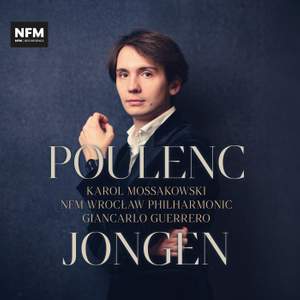Poulenc / Jongen
Karol Mossakowski (organ), NFM Wroclaw Philharmonic, Giancarlo Guerrero
-
International Classical Music Awards2024Nominated - Concerto
CD
$21.00Downloads
What are FLAC and MP3?Contents
Poulenc: Concerto in G minor for Organ, Strings & Timpani
Work length23:05
$8.00
$10.40
$14.00
- NFM Wrocław Philharmonic, Karol Mossakowski, Giancarlo Guerrero
I. Andante
Track length3:20
$1.00
$1.30
$1.75
II. Allegro giocoso
Track length2:04
$1.00
$1.30
$1.75
III. Andante moderato
Track length7:34
$2.00
$2.60
$3.50
Jongen: Symphonie Concertante for Organ & Orchestra, Op. 81
Work length36:17
$8.00
$10.35
$14.00
- NFM Wrocław Philharmonic, Karol Mossakowski, Giancarlo Guerrero
I. Allegro, molto moderato
Track length8:55
$2.00
$2.60
$3.50
II. Divertimento: Molto vivo
Track length9:08
$2.00
$2.60
$3.50
III. Molto lento: Lento misterioso
Track length12:35
$3.00
$3.85
$5.25
IV. Toccata (moto perpetuo): Allegro moderato
Track length5:39
$1.00
$1.30
$1.75






